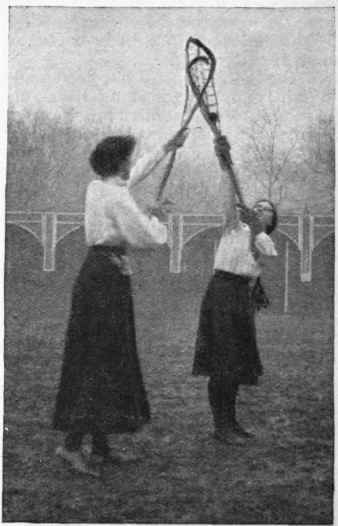Recreations - Lacrosse As A Game For Girls. Part 4
Description
This section is from "Every Woman's Encyclopaedia". Also available from Amazon: Every Woman's Encyclopaedia.
Recreations - Lacrosse As A Game For Girls. Part 4
A player has the right to appeal direct to the referee should any case of "rough play" or "foul play" occur.
The rules regarding touts are as follows:
1. No player may stand inside the goal - crease, or check the goalkeeper within it, until the ball has passed within the crease. This rule, however, does not prevent a player from running across a corner of the goal-crease to field a wide ball.
2. No player may interfere in any way with another who is in pursuit of an opponent.
3. No player, except the goalkeeper, may wilfully touch the ball with her hand, nor may she wilfully fall and cover it with her body.
4. When a ball lodges in a place inaccessible to her crosse, or about her clothing, the player must at once remove it, and "face" with her nearest opponent, all other players remaining in the position which they then occupy.
5. Should the ball catch in the netting, the crosse must at once be struck on the ground, and the ball dislodged.
6. No player may grasp an opponent's crosse with her hands, hold it with her arms, or between her legs, or under her feet, or kick it.
As regards rough play, the rules lay down that 1. No player may hold, trip, push, deliberately charge or shoulder an opponent, or wrestle with the legs entwined so as to throw her.
This, however, does not prevent the use of the "body check" (provided it consists only of placing one's body in the way of an approaching opponent so that the latter is simply impeded, but the checker may not use force in the body check), nor the pushing of an opponent with the shoulder in ground scuffles.
2. No player may deliberately strike another, nor threaten to do so.
3. The check known as the "square" check, or "crosse" check, which consists of one player charging into another with both hands on the crosse so as to make the stick meet the body of her opponent, is strictly forbidden.
4. No player may throw her crosse, under any circumstances.
For fouls Nos. 1, 2, 3, 5, and 6, the referee may order either a "face" or a "free position" at the place where the foul occurred, but the "free position" must not take place within ten yards of the centre of goal. The ten yards shall be measured in a straight line from the centre of goal through the place where the foul occurred.
If a player persists in claiming fouls on trivial grounds, the referee shall first caution, and then disqualify, her until a goal is scored.
The penalties for any of the offences known as "rough play" are either a "free position" for the side offended against, or suspension of the offending player until a goal is scored, or even for the remainder of the match.

Diagram of the field, showing relative positions of players
"Stand!" The ball is dead when the referee blows her whistle, and no player may move until the referee calls "Play!"
"Free Position." The players shall "stand," except the goalkeeper, who may resume her place, and the player to whom the referee accords the "free position," and no other player, may be nearer than five yards to the taker of it. If anybody be within the prescribed distance she must retire to the satis -faction of the referee. The player accorded the "free position" shall then take the ball on the crosse in front of her, and at the sound of the whistle the game shall proceed. Lacrosse is one of the most enthralling and exciting games imaginable from the onlooker's point of view, and it would be hard to find a prettier or more exhilarating scene than a girls' lacrosse match in full swing. There is not a dull moment in the game; the graceful attitudes of the players and exciting tussles combining to make a delightful show.

A tussle for the ball in mid-air
Continue to:


